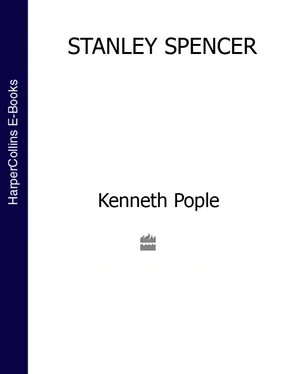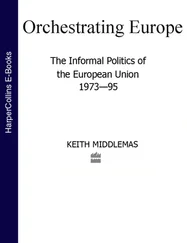The comment is again significant in interpreting not only this painting but much of Stanley’s visionary art. He is warning us away from seeing the painting in terms of pure emotion. However sad his feelings and of those around him on that day, the painting is not ultimately about those feelings, and he is not imputing them to Christ. Christ is simply doing the job he has to do, as Stanley, off to the war, is doing what he has to do. The job, the fact, the event exists in its dispassionate reality. Stanley’s struggle to use recalled emotion in the creation of visionary allegory meant that he had to detach the emotion from whatever event aroused it for him. Throughout his life, the struggle, both in behaviour and in art, will continue, making his actions seem detached at times. When, for example, in his letters or writings he reveals strong feelings about an event, they are seldom concerned specifically with the event itself or with the cause of the event, but with his own or others’ ability – or more usually inability – to appreciate the implications, the transcendence, he finds in it.
Such detachment however does not imply that he was anaesthetized to the emotions he was recalling. Twice in his comments on the painting Stanley refers to the three onlookers – himself in recollection – as ‘louts’, a strongly condemnatory epithet in his vocabulary. 9The most likely reason is that the dilemma he is recollecting in the incident is so strong that he finds it necessary angrily to belittle it. He transfers the pain of his self-searching to painted representations of himself watching his more visionary self dredging from his memory-feeling the painful visual elements so necessary to composition. Like someone half in and half out of a bad dream he introduces a defensive technique to limit his pain. He turns himself into a doppel-Stanley. Indeed in this case the procedure armours him sufficiently to be able to tell a later friend with some good humour that he is aware that his depiction of Fernlea-Belmont ‘looks rather like a diseased potato’. 10But there speaks the everyday Stanley. The visionary Stanley knows that the imagery, strange though he finds it, is exact to his purpose. It is, he says, ‘wonderful’.
In this painting, Christ Carrying the Cross , Christ the Son of God is preparing for the final agony which will redeem his creation. Stanley too is entering an agony with the same inevitability. He will endure whatever befalls him in the implicit trust that he too must find redemption in his own purpose and creativity. In the top right of the painting Stanley inserts, out of its true position, one of the cowls of Cookham’s malthouses. His grandfather is said to have had the building of them. The eye of God is upon him. 11
Stanley has given the painting flat tones and an unfamiliar, abstract quality, almost a floating sensation. Looking back, he doubted whether it conveyed the transcendence he sought: ‘The Cross, as far as its position in the picture is concerned is right enough. But I still feel it is a pity that I failed to arrive at the notion I had hoped.’ 12The Cross and its transfiguration of the material into the spiritual is the theme of the painting. When Stanley’s dealer subsequently asked him if he should catalogue it as Christ Carrying His Cross , Stanley again furiously corrected him. Its title, he said, was Christ Carrying the Cross.13 The Cross is universal. It represented for Stanley, as he assumed it represented for all, a necessary submission to the perpetual confusions and frustrations of existence from which it is our purpose to seek redemptive meaning. All Stanley’s powers of spiritual awareness would be needed if he was to find the true meaning of the agony of the next four years.
PART TWO
The Confusions of War
1915–1918
CHAPTER ELEVEN
The Burghclere Chapel: The Beaufort panels
‘An ideal place for a sick man. No wonder they so rapidly recover.’
King George V to Lieutenant-Colonel R. Blachford, Superintendent of the Beaufort War Hospital, September, 1915 1
IN LATER LIFE Stanley was to assert that after 1919 he resolutely ‘turned his back’ upon the Great War. In the sense that he did not use his experiences in the way that many of the war poets and artists used theirs, his assertion is valid enough. But to interpret his statement as discounting all war influence in his art is patently absurd. War memories can be traced in many later paintings, and without some knowledge on our part of their origin in his war service, the force of these paintings is diminished. For Stanley, as for countless young men of his generation, the shock of war was to prove ineradicable. Only time, or in Stanley’s case an attempted sublimation offered comfort, and the greatest of the redemptions he undertook was the Sandham Memorial Chapel at Burghclere painted between 1927 and 1932. Of the sixteen side-wall panels in that masterwork, ten re-create the Beaufort War Hospital. 2
The hospital, Stanley’s ‘roaring great hospital’ – it had 1600 beds – had been hastily converted three months earlier from the Bristol Lunatic Asylum. Most of the thousand or so inmates, men and women, were moved to rural asylums, about eighty being retained for domestic duties. Assigned to the patronage of the Duke of Beaufort, the ad hoc hospital was a typical 1860s institutional building comprising a central administrative and service block from which ward wings extended right and left. Across these, at intervals, other wards ran transversely, enclosing small courts. The right half, facing the building, had been the male half, the left the female. The male hospital staff had been ‘volunteered’ into the Royal Army Medical Corps with rank appropriate to their status; the superintendent and medical staff as officers, the administrative and supervisory staff as sergeants and corporals. The female staff, having no surgical nursing qualifications, became auxiliary nurses, augmented by Red Cross nursing volunteers and supervised by an intake of army nursing sisters from Queen Alexandra’s Imperial Military Nursing Service who, as most old soldiers will confirm and as Stanley was to discover, were formidable authoritarians. There Stanley joined a number of young volunteer orderlies like himself. Because they were known only by surname, and Gilbert, having arrived first and being bigger in build, was mistaken as the elder, Stanley was invariably referred to as ‘young Spencer’.
The first panel on the left wall in the Burghclere Chapel, showing a Convoy of Wounded Soldiers Arriving at Beaufort Hospital Gates , hints at Stanley’s impressions on arrival. The wounded were shipped to Southampton from France or to Avonmouth from the Dardanelles and were entrained in ‘convoys’ to Temple Meads Station in Bristol. From there they were ferried to the hospital in a motley collection of vehicles or, as in the case of the ‘walking wounded’ in the painting, in requisitioned omnibuses. At this still excited state of the war, they were cheered through the streets of Bristol by passers-by. A convoy could consist of several hundred patients and the duty staff had to work frantically to register, examine, bath and install them with their kit – the Sorting and Moving Kitbags panel.
The orderlies, normally two to a ward, came under the jurisdiction of the Ward Sister. Their duties combined those of a modern hospital porter with those of a ward auxiliary. They had to make beds – Bedmaking ; do dressings, as in scraping the dead skin from a patient’s foot in Patient Suffering from Frostbite ; and scrub and polish everything in sight – Ablutions, Scrubbing the Floor and Washing Lockers :
I have done nothing else but scrub since I have been here. I think it has done me good. I think with pleasure of the number of men I have bathed every Wednesday morning. I have to bath patients at 6.00 a.m.; I do it in an hour and a half. When I am seeking the Kingdom of Heaven I shall tell God to take into consideration the number of men I have cleaned and the number of floors I have scrubbed, as well as the excellence of my pictures, so as to let me in. 3
Читать дальше









![Brian Thompson - A Monkey Among Crocodiles - The Life, Loves and Lawsuits of Mrs Georgina Weldon – a disastrous Victorian [Text only]](/books/704922/brian-thompson-a-monkey-among-crocodiles-the-life-thumb.webp)


